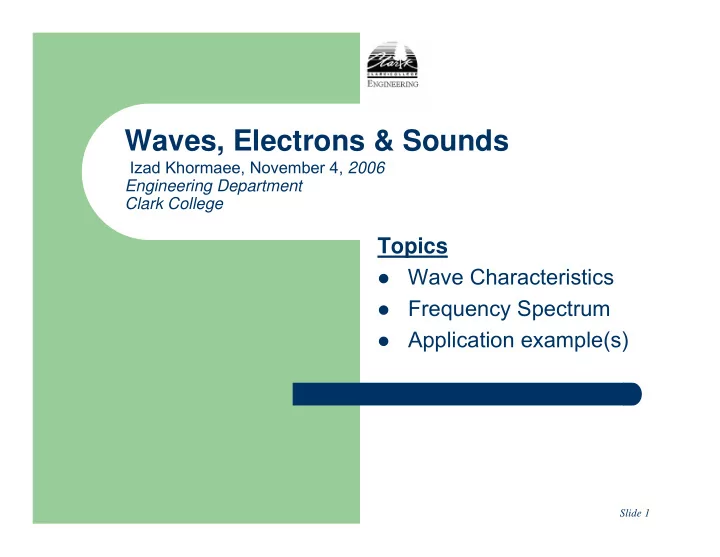

Waves, Electrons & Sounds Izad Khormaee, November 4, 2006 Engineering Department Clark College Topics Wave Characteristics � Frequency Spectrum � Application example(s) � Slide 1
Wave Characteristics � Frequency in Hertz, f f = number of times a repeats in one second. Example: f=1000 Hz 0 . 1/1000 1/2000 Sec. Sec. Sec. � Wave length λ = “speed of light” / f Example: λ = 300,000,000 / 1000 = 300,000 meters Slide 2
What can we hear? � Perfect hearing range: 20 – 20,000 Hertz � Typical hearing range: 100 -15,000 Hertz Source: nysinuscenter.com Slide 3
What can we see? � Range for visible light: 3x10 14 - 7.5x10 14 Hz Source: stlukeseye.com Slide 4
Frequency Spectrum Red Violet Visible {Freq :3 - 7.5x10 14 Hz; Wavelength: 700 – 400 nanoMeter} Gamma rays Radio Infared Ultraviolet AM {540-1650 KHz}; FM {88-108 MHz}; Microwave far Near Near Far X rays Soft Hard Frequency, c (Hertz) 10 3 10 7 10 11 10 15 10 19 10 23 Wavelength, λ (Meters) 3x10 5 3x10 1 3x10 -3 3x10 -7 3x10 -11 3x10 -15 Mount Human Atomic Scale Virus Everest Height Nucleus Atmosphere Atmosphere Opacity is Opaque Radio Window Optical Window f: 2x10 7 to 2x10 10 Hz c: 3x10 13 to 3x10 15 Hz λ : 10 -5 to 10 -7 Meters λ : 20 to 2x10 -2 Meters Slide 5
Experiment “Paper Cup Speaker” Slide 6
Experiment: Paper Cup Speaker Slide 7
Sound Generation 1. The alternating current from the source flows through the wire in a circular pattern. 2. This creates an alternating magnetic field through the center of the coil. 3. As the magnetic field through the loop of wire changes, the permanent magnet repels and attracts the coil of wire. 4. This action causes the bottom of the cup to vibrate. 5. The vibration in the bottom cup causes the air pressure to change through the body of the cup, creating sound waves. Slide 8
Experiment: Hear & See Sound Waves � Turn on the signal generator (1 Volt, 1000 Hertz) and connect the Ogden speaker. “ What are you hearing?” � Connect the oscilloscope to the signal generator. “What are you seeing?” Slide 9
Generate Sine Waves � Start up MATLAB Program and type the following text in the command window: >> t=[0:1:2000]; >> plot (t, sin(2*pi*t/1000)) � Compare what you see on the screen with the sound you heard from the speaker and the sound that you saw on the oscilloscope. Slide 10
Experiment “Self-Contained Motor” Slide 11
Experiment: Self-Contained Motor Build a motor using: • Three magnets • A 20” piece of copper wire • A D-cell battery Slide 12
Components These VERY powerful magnets are made from an alloy of the rare earth element Neodymium, along with Iron and Boron. This is the most powerful permanent magnet alloy known. Slide 13
Instructions Place the two small disk magnets together. 1. Place the two disks on top of the north pole of 2. the cube magnet. The loop in the bottom of the wire form is then 3. placed on top of the two disks. The loop is just barely larger than the disks. Place the positive pole of the battery on top of 4. the disk magnets. Place the pointed end of the wire form in the 5. dimple at the top of the battery. Be careful, wire may be hot! When the whole structure is balanced on the 6. cube magnet, the wire begins spinning around the battery as is shown in the picture. Hint: Forces generated are small, so make sure that the wire can turn freely. Slide 14
B How does it work? I F F I I F=Force Battery B=Magnetic Field I= Current F B B Bottom view of battery without magnets Slide 15
Theory in Words The current from the battery is flowing outwards 1. from both sides of the wire. This creates a magnetic field around the wire. This 2. field interacts with the field from the cube magnet and the disks. The wire's field creates a force at right angles to 3. the field from the magnets. This causes the right side of the wire to be pushed towards you, and the left side to be pulled away from you. This action continues until the battery runs down. 4. Slide 16
Recommend
More recommend